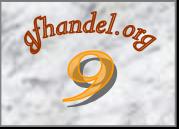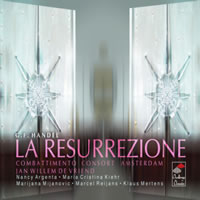Although for a long time the librettos of Il Trionfo del Tempo e del
Disinganno and La Resurrezione were dismissed as unwieldy or
slow moving while the music itself received little attention, Handel’s
earliest oratorios composed in Rome between 1707 and 1708 have both become
considerably more popular in recent times. Indeed, arguments that they are
undramatic or of little interest have been proved utterly wrong. Both of
Handel’s Catholic oratorios – really operas on religious topics, much like
the later English theatre works – are fabulous gems.
La Resurrezione was composed for the Marchese Ruspoli as part of
his spectacular Easter celebrations in 1708. Handel resisted attempts to
convert him to the Roman Catholic Church, but this oratorio proves he
certainly did not resist the influence of its music. In addition to
Handel’s own artistic originality and vivid brilliance, his absorption of
the styles of composers such as Alessandro Scarlatti and Antonio Caldara
is plainly evident. Another influence was Corelli, who led the unusually
large orchestra that probably consisted of about 21 violins, 4 violas, a
viola da gamba, 5 cellos, 5 double basses, 4 oboes (who also doubled on
recorders and flute), 2 trumpets, theorbo, and harpsichord. It is also
possible that a bassoonist used trombone in music where Handel indicated
trumpets.
The libretto was written by Carlo Sigismondo Capece, a member of the
Arcadian Academy, yet the intense emotions and vivid drama are far removed
from pastoral musings. The libretto does not feature a musical portrayal
of Christ, but instead a series of comments from Mary Magdalene, Mary
Cleophas, and St. John. Their grief is potent, and their subsequent
rejoicing after the Angel announces His resurrection is infectious.
Furthermore, the oratorio’s opening scene featuring a gloating Angel’s
arrival at the gates of hell – and Lucifer’s impotent venom – is Handel at
his most purely theatrical.
This is the fifth recording of this captivating work, and it is a
thoroughly enjoyable and valuable addition to its predecessors. Do not be
fooled by its description as a ‘live recording’, its obscure Dutch label,
or the fact that the Combattimento Consort Amsterdam plays on modern
instruments. Such things may put some people off trying this, but, to be
blunt, that would be their loss: the sound quality is magnificent, the
product is well documented (the excellent essay and libretto translation
are written by scholar Anthony Hicks), and the orchestra’s playing is
impeccably stylish and compelling.
Although this performance is not without a few tiny quirks, I never sensed
that anything was being done to detract from the characters in the story
or the musical qualities in Handel’s score. Indeed, after listening to
this interpretation a few times, I was struck by how natural and ‘right’
much of it seems. Credit for that must go to director Jan Willem De Vriend,
who judges each number perfectly. The story flows with captivating effect,
and the music is always fresh and shapely. Tempos are never sluggish or
forced to either extreme, and each ritornello perfectly captures its
aria’s essence.
The first-rate cast features universally excellent singers. Admittedly,
most have done more remarkable work elsewhere, but their commitment to the
cause and general vocal quality is beyond dispute. Nancy Argenta’s Angel
is not as smooth as perhaps it once could have been, but her graduation up
the celestial hierarchy (she sang Maddalena on Ton Koopman’s recording,
Erato) is most welcome. Maria Cristina Kiehr is ideally cast as Maddalena,
and is certainly an improvement on Jennifer Smith (Marc Minkowski, DG) and
Judith Nelson (Nicholas McGegan, Harmonia Mundi). Some of the
ornamentation in the da capo of ‘Ferma l’ali’ is a little swoopy, but her
engaging characterisation – including a vivacious ‘Ho un non so che nel
cor’ - more than compensates for it. Marijana Mijanovic is particularly
impressive as Cleofe, and her ‘Naufragando va per l’ onde’ is just one of
the recording’s many outstanding moments. Klaus Mertens’s Lucifer evokes a
certain degree of sympathy during his hopeless tirades, and Mertens
obviously enjoys such villainous music without needing to become
heavy-handed. Marcel Reijans is perhaps the least satisfactory element,
but his strong and rather legato tenor gets the job done without creating
any upsets.
This is the most consistent performance of La Resurrezione on disc
since the oratorio was first recorded by Christopher Hogwood (Decca). It
is less wilfully eccentric than Koopman, and more even in vocal quality
than McGegan. Hogwood’s freshness has still not diminished, but before
this new recording I had personally rated Minkowski’s as the most
dramatically gripping version (his San Giovanni, John Mark Ainsley,
remains by far the best). However, an ideal La Resurrezione might
have been something that took Minkowski’s flamboyance and matched it with
Hogwood’s tastefulness and gentler handling of the orchestra. I would
suggest that Jan Willem de Vriend and his Combattimento Consort Amsterdam
have achieved exactly that.


